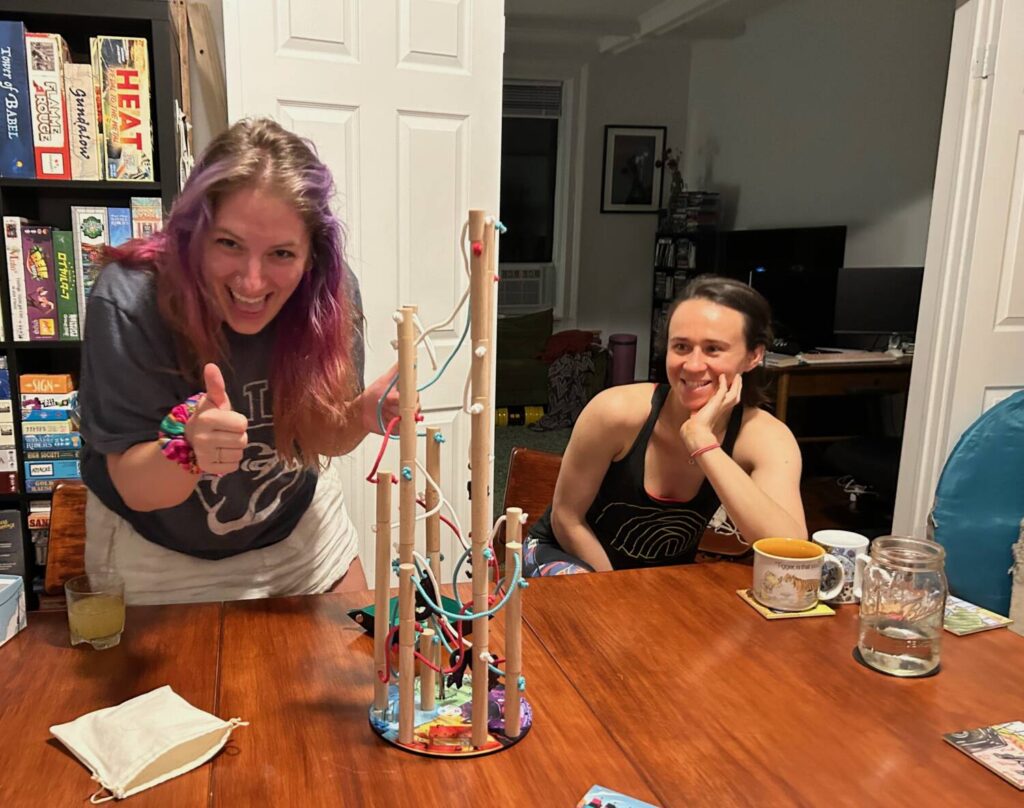Disclosure: Meeple Mountain received a free copy of this product in exchange for an honest, unbiased review. This review is not intended to be an endorsement.
There’s something about stacking games. You can’t ignore them. They command your attention. Try walking by Rhino Hero: Super Battle without stopping to investigate. It’s impossible. Game go up? Tell me more.
Nekojima, from designers David Carmona and Karen Nguyen, certainly goes up. Turn after turn, you add to the power infrastructure of this cat island, placing pairs of wooden dowels connected by brightly-colored bits of rope onto the small circular board. Those dowels stack up and up and up, scaling heights that frankly don’t seem possible.
I am, I’ll confide in you, enthralled by these components. The dowels are a wonder. They stack so much higher than feels reasonable, given their weight and their size. I was so taken by the thought that clearly went into them—light enough to stack without threatening to collapse while simultaneously heavy enough to be sturdy—that I emailed Unfriendly Games to learn more.
They’re made of beech. Honestly, I was disappointed to get so little information. I wanted to learn everything about the development process. Why were other woods rejected? How many woods did they try? Did they look at non-wood materials? Did they experiment with different ropes?
Reader, I would watch a documentary.
Game Go Up
A turn is simple. You roll two dice, which correspond to the four pie slice-regions of the pie-shaped board. The results dictate where you have to set the two ends of your power line. One face of each die lets the active player choose, while another lets the player to your right decide. Once the two regions—they can match—have been set, the player then draws a cube out of the large cloth bag. The color of the cube dictates which set of power lines you can choose from. The three colors—red, white, and blue—correspond to different lengths of rope, from short to long respectively.
You have to place the wooden dowels upright on either the board or on top of other dowels without touching the rope. The rope is also not allowed to touch the board, or other ropes. It makes sense. Bad things happen when power lines meet, I’m told.
Every now and then, a player pulls a black cube out of the bag, which they get to then unload onto some poor, unsuspecting player. If you have any black cubes at the start of your turn, you have to add one cat per cube to power lines on the board. Play continues until all the pieces have been placed—good luck with that—or the structure falls. Much like Rhino Hero: Super Battle or Jenga, there isn’t a winner so much as there’s a loser.
There isn’t much specific to say about Nekojima, but don’t let that be confused for a lack of quality. It’s good! A joy! Do you like stacking? Do you enjoy watching other people sweat profusely as they attempt to wriggle their way out of a jam? Do you revel in celebrating when they do, in fact, wriggle their way out of that jam? Do you relish watching them fail? I do. Guilty on all counts. That’s Nekojima, plain and simple.
Nekojima includes rules for a competitive and a cooperative mode, but competition is never really the point of a stacking game. Like most stacking games, Nekojima doesn’t really draw your attention to the competitive aspects of play. There is technically a winner, or at least a loser, but nobody’s paying attention to that. That isn’t the point. You do do things to make life more difficult for other players, and you do enjoy doing that, but nobody remembers who won a game of Nekojima. That’s not why we’re here. We are here for one thing, and one thing only: Game go up.













